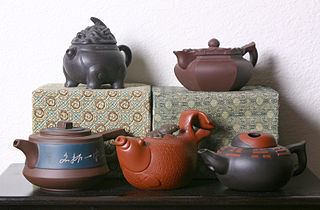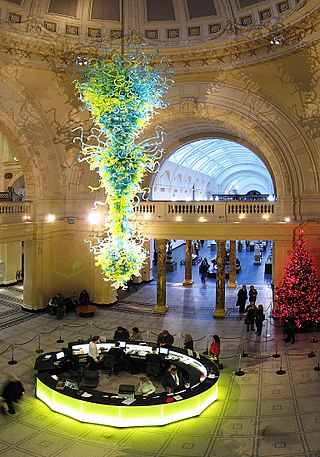This article needs additional citations for verification .(September 2013) |
Yixing Factory Number One is the oldest teapot factory in China. The factory houses skilled artisans who set strict standards for their work.
This article needs additional citations for verification .(September 2013) |
Yixing Factory Number One is the oldest teapot factory in China. The factory houses skilled artisans who set strict standards for their work.
In 1918, the Jiangsu Provincial Ceramics Factory was established for the production of pottery using Yixing clay. By 1932, more than 600 craftspeople worked in Yixing. During the Japanese invasion, the artists scattered and many subsequently died. Under the People's Republic of China government, industry began to revive. [1] In 1954, 59 potters began the Zisha production group of the Shushan workshop with funding from the Tangdu Pottery co-operative. The government established Factory No. 1 in April 1958. Before that time, no proper ranking existed for the craftsmen. Every maker mined, mixed and took courses and exams to be recognised. It took about three years of training to advance through the system. At each stage the craftsmen were required to complete a test to attain a new title. The craftsmen would begin as an 'Assistant Master Craftsman', then ascend through the ranks of 'Master Craftsman', 'Senior Master Craftsman' and finally 'National Master Craftsman'. Their signature product was artisan-crafted teapots.
Starting in 1966, the Cultural Revolution [2] led Factory No. 1 to begin to produce utilitarian pots in a style known as shui ping hu in vast numbers. Instead of having the name of the craftsman who made the pot on the bottom, these pots had characters that represented Yixing. [3] During this time, the factory walls were filled with slogans painted in red that insisted that art was for the people and not for self-aggrandizement. Many connoisseurs still prize these pots for their simplicity and quality.
With the end of the Cultural Revolution, new ranks for craftsmen were subsequently introduced in the 1970s:
Today, teapots produced by the factory are diverse and creative; masters have resumed signing their work and their creations are in high demand. Waits for a master craftsman's commissioned pot can reach up to two years.[ citation needed ]
Gu Jingzhou, one of the founders and deputy director of Research and Technology at the factory, was an accomplished master artist. His teapots have sold for up to $US 2 million. Jiang Rong was a Grand Master. Her teapots emulated nature. Ren Ganting (1889-1968), an ambidextrous artist who created natural forms, participated in the National Labour Heroes Convention. Pei Shimin (1892-1979) started making teapots at age 14. Zhu Kexin (1904-1986) began making teapots before the war and worked in the Jiangsu factory as a youth. He has since received many honours. [1]
Yixing Factory No. 2 was formed in 1984 by brothers Xu Siew Tang and Xu Han Tang, both master craftsmen. They managed to lure some craftsmen and women from Factory No. 1 to join them.

A teapot is a vessel used for steeping tea leaves or a herbal mix in boiling or near-boiling water, and for serving the resulting infusion which is called tea. It is one of the core components of teaware. Dry tea is available either in tea bags or as loose tea, in which case a tea infuser or tea strainer may be of some assistance, either to hold the leaves as they steep or to catch the leaves inside the teapot when the tea is poured. Teapots usually have an opening with a lid at their top, where the dry tea and hot water are added, a handle for holding by hand and a spout through which the tea is served. Some teapots have a strainer built-in on the inner edge of the spout. A small air hole in the lid is often created to stop the spout from dripping and splashing when tea is poured. In modern times, a thermally insulating cover called a tea cosy may be used to enhance the steeping process or to prevent the contents of the teapot from cooling too rapidly.

Chinese tea culture includes all facets of tea, both physical and spiritual, that have significantly influenced Chinese culture throughout history. Physically, it consists of the history of tea cultivation, brewing, serving techniques, methods of consumption, arts, and the tea ceremony. Tea culture is to take tea as a carrier, and through this carrier to spread various arts. Tea culture is an integral part of traditional Chinese culture. Tea culture is the organic fusion of tea and culture, which contains and embodies the manifestation of a certain period of material and spiritual civilization. Tea culture is the combination of tea art and spirit, and the expression of tea art through Spirituality. It emerged in China in the Tang dynasty, flourished in the Song and Ming dynasties, and declined in the Qing dynasty.

Pottery and porcelain is one of the oldest Japanese crafts and art forms, dating back to the Neolithic period. Kilns have produced earthenware, pottery, stoneware, glazed pottery, glazed stoneware, porcelain, and blue-and-white ware. Japan has an exceptionally long and successful history of ceramic production. Earthenwares were made as early as the Jōmon period, giving Japan one of the oldest ceramic traditions in the world. Japan is further distinguished by the unusual esteem that ceramics hold within its artistic tradition, owing to the enduring popularity of the tea ceremony.

Historically, a master craftsman or master tradesman was a member of a guild. The title survives as the highest professional qualification in craft industries.

The Korean tea ceremony is a traditional form of tea ceremony practiced in Korea. Darye literally refers to "etiquette for tea" or "tea rite" and has been kept among Korean people for over a thousand years. The chief element of the Korean tea ceremony is the ease and naturalness of enjoying tea within an easy formal setting.

Yixing clay is a type of clay from the region near the city of Yixing in Jiangsu Province, China, used in Chinese pottery since the Song dynasty (960–1279) when Yixing clay was first mined around China's Lake Tai. From the 17th century on, Yixing wares were commonly exported to Europe. The finished stoneware, which is used for teaware and other small items, is usually red or brown in colour. Also known as zisha (宜興紫砂) ware, they are typically left unglazed and use clays that are very cohesive and can form coils, slabs and most commonly slip casts. These clays can also be formed by throwing. The best known wares made from Yixing clay are Yixing clay teapots, tea pets, and other teaware.

A tea set or tea service is a collection of matching teaware and related utensils used in the preparation and serving of tea. The traditional components of a tea set may vary between societies and cultures.

American craft is craft work produced by independent studio artists working with traditional craft materials and processes. Examples include wood, glass, clay (ceramics), textiles, and metal (metalworking). Studio craft works tend to either serve or allude to a functional or utilitarian purpose, although they are just as often handled and exhibited in ways similar to visual art objects.

Chinese ceramics show a continuous development since pre-dynastic times and are one of the most significant forms of Chinese art and ceramics globally. The first pottery was made during the Palaeolithic era. Chinese ceramics range from construction materials such as bricks and tiles, to hand-built pottery vessels fired in bonfires or kilns, to the sophisticated Chinese porcelain wares made for the imperial court and for export. Porcelain was a Chinese invention and is so identified with China that it is still called "china" in everyday English usage.

Sprigging or sprigged decoration is a technique for decorating pottery with low relief shapes made separately from the main body and applied to it before firing. Usually thin press moulded shapes are applied to greenware or bisque. The resulting pottery is termed sprigged ware, and the added piece is a "sprig". The technique may also be described by terms such as "applied relief decoration", especially in non-European pottery.

Yixing clay teapots, also called Zisha teapot, are made from Yixing clay. This traditional style commonly used to brew tea originated in China, dating back to the 15th century, and are made from clay produced near Yixing in the eastern Chinese province of Jiangsu.

Chantilly porcelain is French soft-paste porcelain produced between 1730 and 1800 by the manufactory of Chantilly in Oise, France. The wares are usually divided into three periods, 1730–1751, 1751–1760, and a gradual decline from 1760 to 1800.

Ceramics in Mexico date back thousands of years before the Pre-Columbian period, when ceramic arts and pottery crafts developed with the first advanced civilizations and cultures of Mesoamerica. With one exception, pre-Hispanic wares were not glazed, but rather burnished and painted with colored fine clay slips. The potter's wheel was unknown as well; pieces were shaped by molding, coiling and other methods,

John Philip Elers and his brother David Elers were Dutch silversmiths who came to England in the 1680s and turned into potters. The Elers brothers were important innovators in English pottery, bringing redware or unglazed stoneware to Staffordshire pottery. Arguably they were the first producers of "fine pottery" in North Staffordshire, and although their own operations were not financially successful, they seem to have had a considerable influence on the following generation, who led the explosive growth of the industry in the 18th century.
Cedar Creek Gallery is a fine craft gallery located in Creedmoor, North Carolina. Craftspeople work alongside each other, fire wood and gas fired kilns, blow glass and make a living as artists onsite. Cedar Creek Pottery and Gallery was started in 1968 by Sid and Pat Oakley on what used to be an old tobacco field. The Gallery has grown from one building into over ten since then. The grounds are well maintained with many plants, flowers and trees.

Redware as a single word is a term for at least two types of pottery of the last few centuries, in Europe and North America. Red ware as two words is a term used for pottery, mostly by archaeologists, found in a very wide range of places. However, these distinct usages are not always adhered to, especially when referring to the many different types of pre-colonial red wares in the Americas, which may be called "redware".

Tea Pet or Tea Lover's Pet, also known as Chachong, is a small pottery figure which is kept by some tea drinkers for good luck. They are usually made of "zisha" or Yixing clay, from the region near Yixing in Jiangsu province, China. Similar to Yixing teapots made from the same clay, tea pets are unglazed, and are mostly monochromatic with a rough surface.
Gu Jingzhou simplified Chinese: 顾景舟; traditional Chinese: 顧景舟; pinyin: Gù Jǐngzhōu was a Chinese ceramic artist who specialised in the creation of zisha-ware teapots. He was a founder and Deputy Director of Research and Technology at the Number One Yixing Factory.
Chris Gustin is an American ceramicist. Gustin models his work on the human form, which is shown through the shape, color, and size of the pieces.
Xu Sihai was a Chinese teapot creator, artisan, collector, and curator. Xu was an expert and authority on purple clay teapots, also known as the Yixing clay teapot. In 1992, Xu founded the Sihai Teapot Museum, the first private museum established in modern Shanghai.